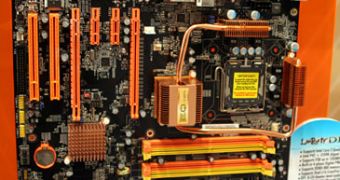After creating a cooling system for its motherboards, DFI returns with a second edition of it, an improved one, which allows customization. The new approach on TransPiper consists in balancing the benefit of heatpipes and also in giving the possibility of customizing the way in which the motherboard is cooled. DFI has worked with Thermalright at this project and they included an interchangeable north bridge cooler in the system.
Usually, on the north bridge sits a small aluminum block which has a small passive cooler on top of it. DFI shows that little effort is spent to interchange an additional Thermalright cooler which cam improve the cooling performances. Also, the rear fins sitting outside the case which used to have one heatpipe now have two, cooled by the rear exhaust, like before.
Adding another cooler to the north bridge may seem more expensive, but the extra cost is covered by the elimination of the need to change the heatsinks the heatpipes cover. And the new cooling formula goes quite well with the X48 motherboard and the DDR3, so it's easy to forget about the costs when you put them together.
When looking at this new system, one understands that DFI is on the right path. There are many features that need attention and they come hand in hand with the new BIOS options that DFI has in store for the users. All are expected to create quite an experience.
DFI intends to use TransPiper on its Nvidia nForce 790i SLI motherboard which is approaching launch day. The motherboard will have all the usual features from DFI: Bernstein audio, eight phase digital PWM, three-way SLI, dual Gigabit Ethernet adapters, eight 3GB/s SATA ports and the aluminum capacitors.
For those who think that this motherboards are a little too expensive, DFI brings the same enthusiastic features and BIOS options on its P45 T2R. Although the TransPiper is not present, it still has the copper pipes to match the profile. The board is DDR2 based and features dual PCI-Express 2.0 x16 CrossFire, two types of Rear I/O S/PDIF, one Gigabit Ethernet adapter and the usual switches. And as it is a DFI, it should run smooth and steady like any DFI, even if not as sparkling as a ROG or Quantum Force board.
The images you can view are taken from Bit Tech.

 14 DAY TRIAL //
14 DAY TRIAL // 

